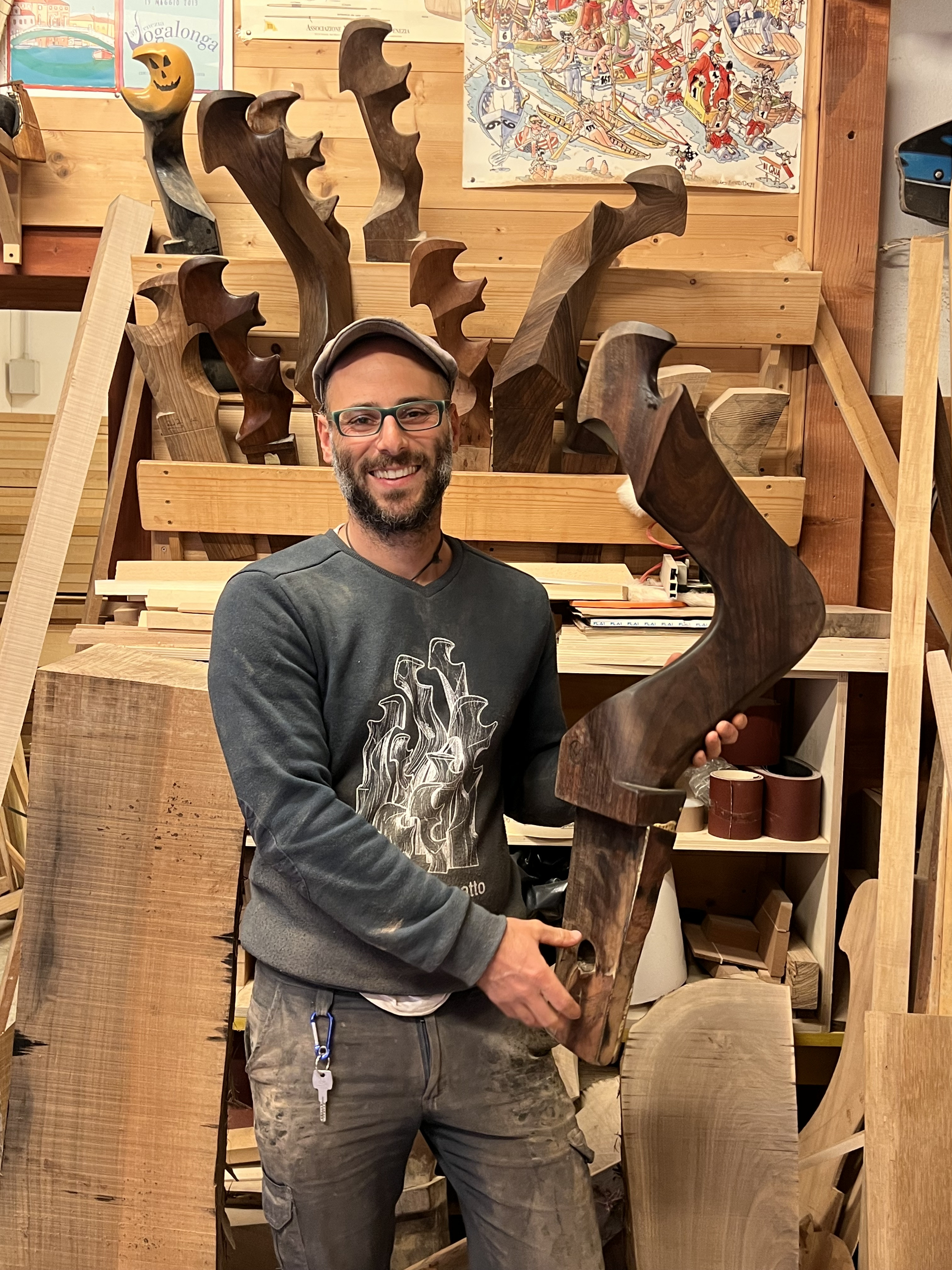
Piero Dri, 2022
Piero Dri is the fourth and youngest remer in Venice, making oars and oarlocks, or in Italian ‘forcolai’. Piero learned how to row aged just four. It's been his passion ever since.
I came to Venice with sound specialist Mike Axinn in April 2022, during the Homo Faber celebration of artisans, for a special Venice series of Materially Speaking. We met three young artisans who are now bringing a fresh energy to the community with a particular eye on repair, re-use and sustainability.
Venice is an extraordinary island city with a rich history, magnificent art and great beauty. However there are no cars and a frail infrastructure. And of course there are the tourists. So we were keen to discover what these artisans bring to Venice and why they like to call it home.
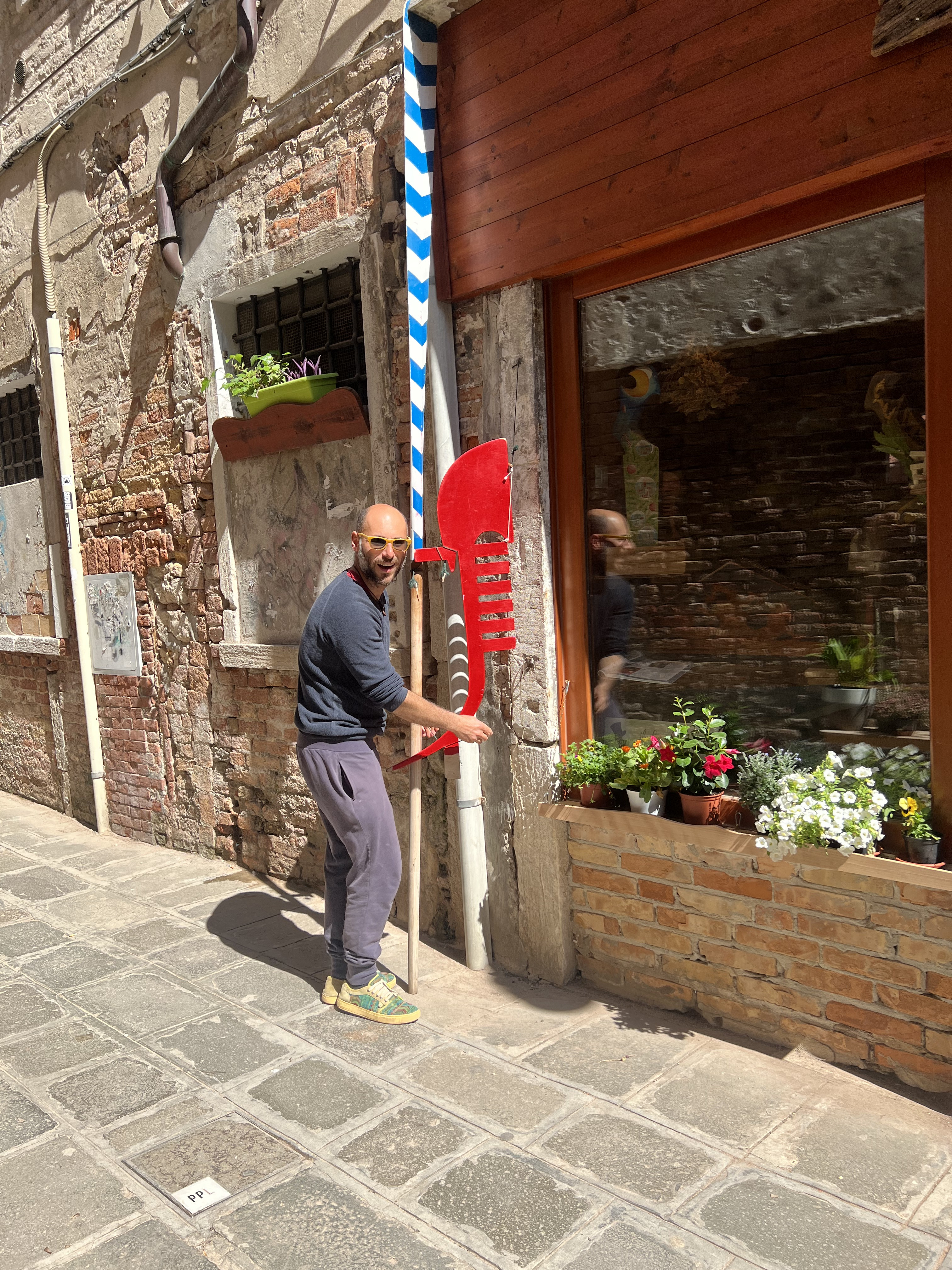
Piero outside his workshop
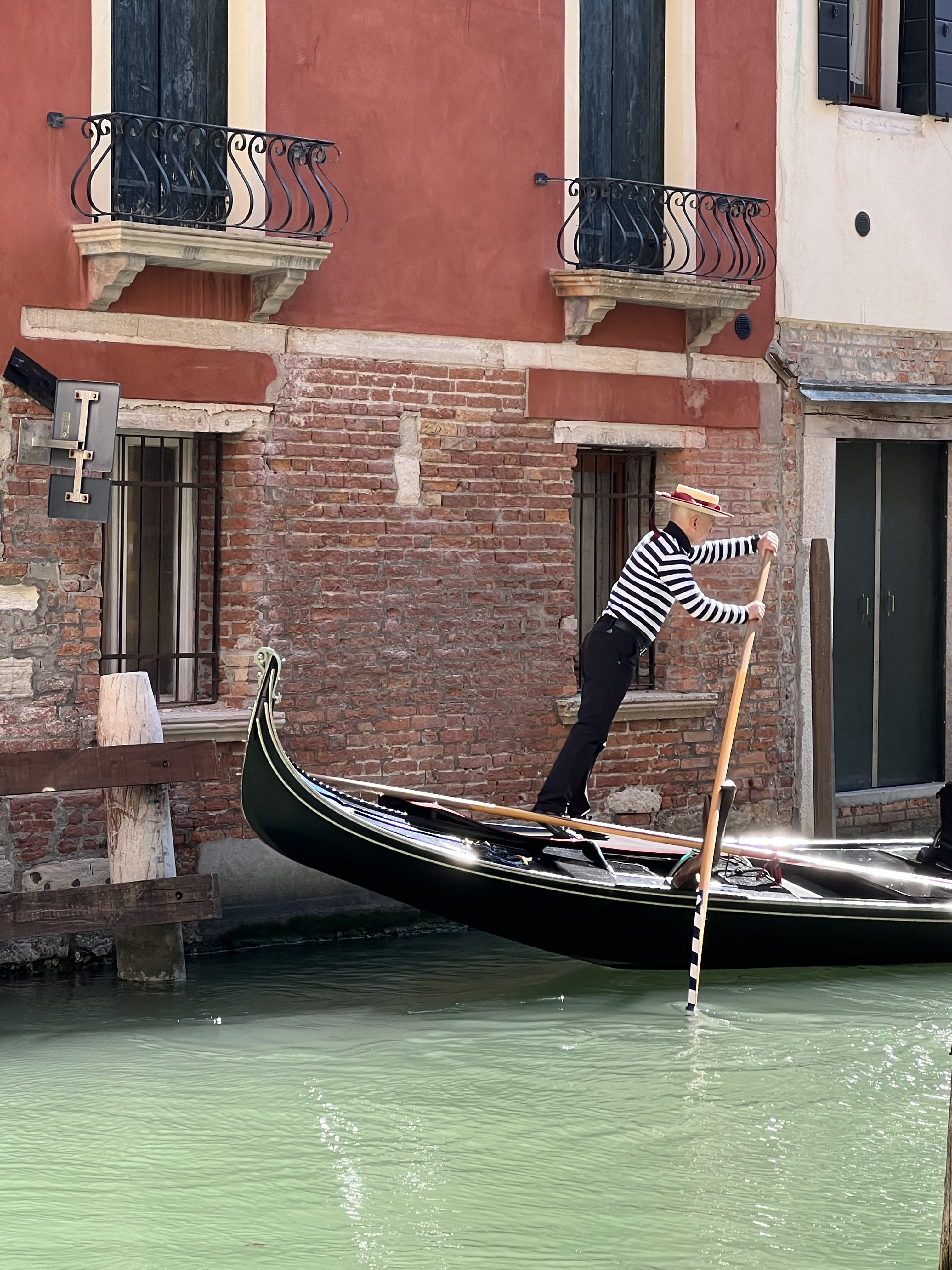
A forcolai on a gondola
Piero’s vibrant personality has earned him the name of the ‘mad forcolai maker’ and so his workshop is called ‘Il Forcolaio Matto.’ As we arrive, Piero is opening up his shop – hooking flower boxes onto his window sill, and leaning a striped oar against the wall.
He tells us about growing up in Venice, and how he escaped to the lagoon when he needed peace and to be with nature. He describes studying to become an astronomer before changing course to take up the life of an artisan.
Piero’s workshops have painted and varnished oars suspended from the ceiling. He speaks about the different woods he uses and the boat community in Venice.
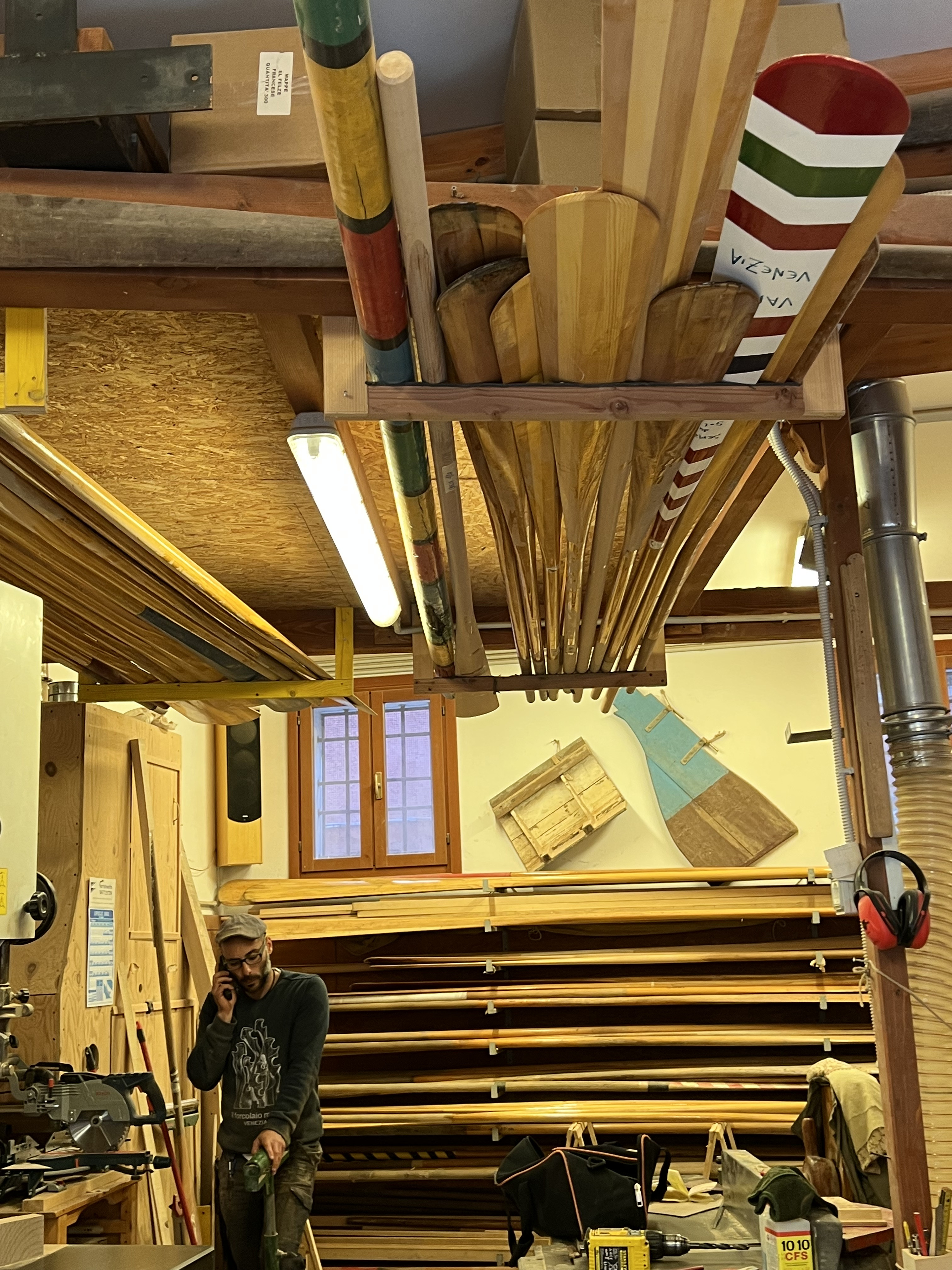
Workshop with oars
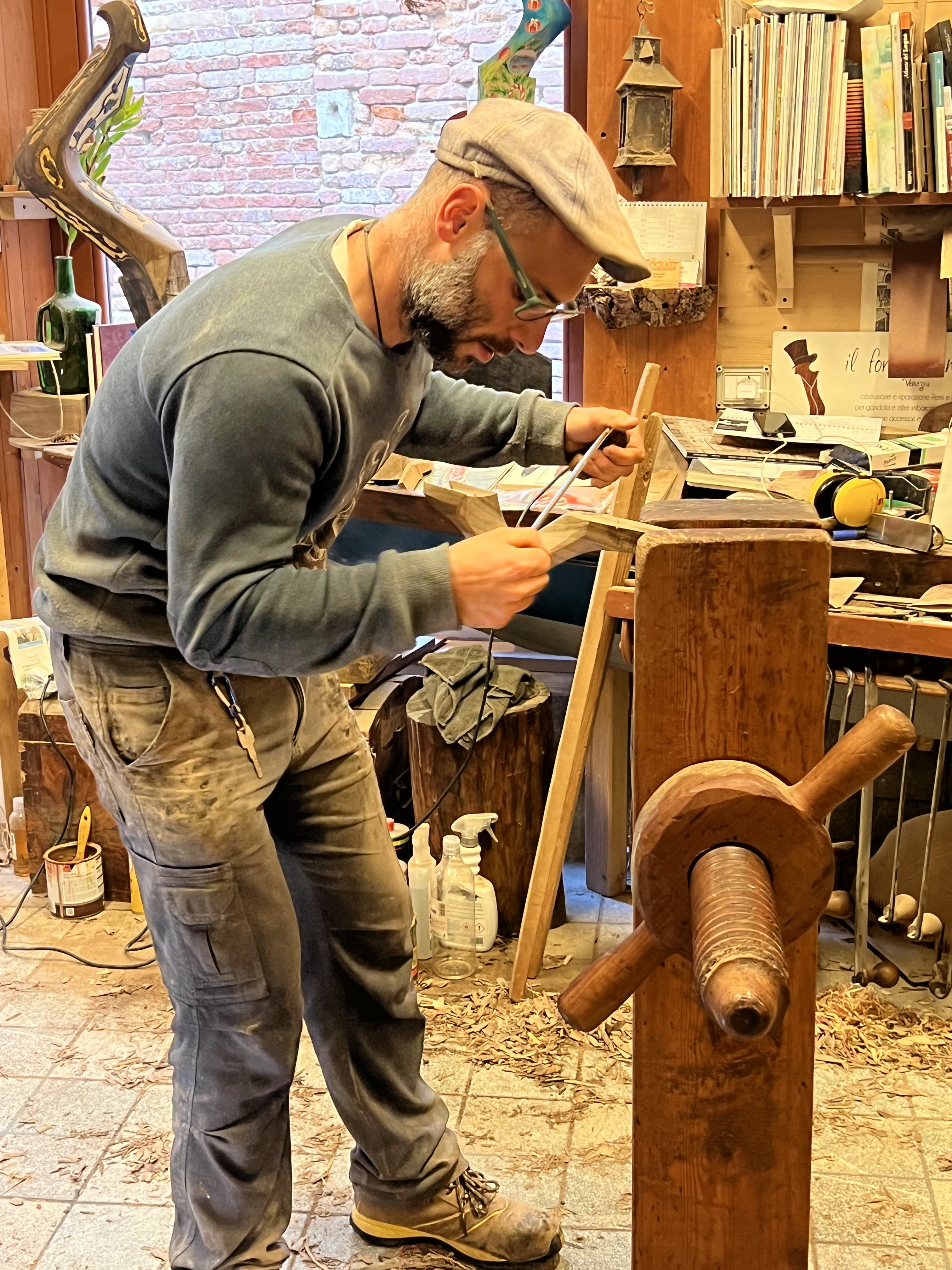
Piero using the clamp
In one window is a display of decorative forcolai, which hold their own as art objects in a variety of gorgeous woods. He speaks of a competition where he created a forcolai to express the natural beauty of the lagoon (see green and yellow forcolai below).
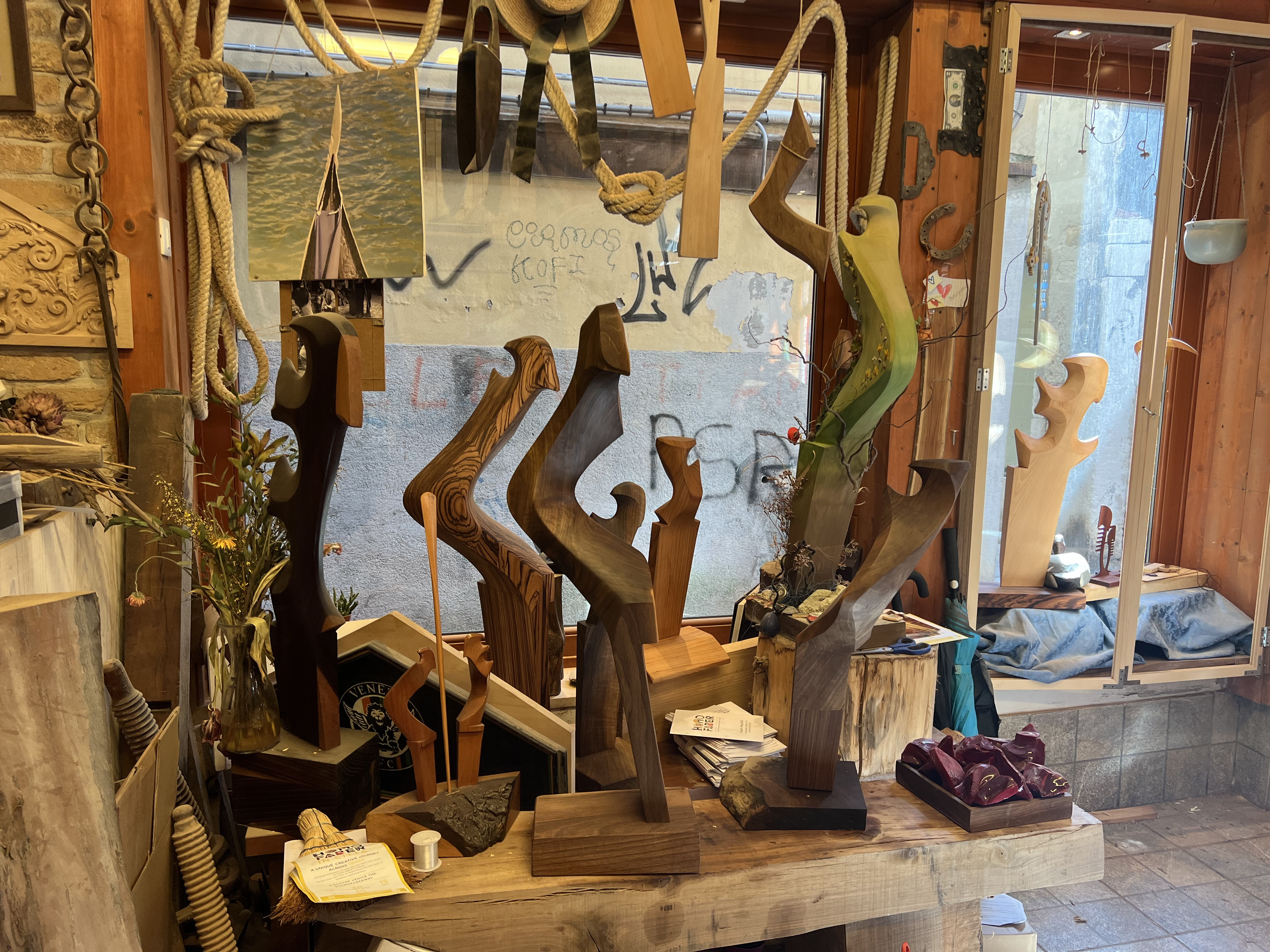
Credits
Producer: Sarah Monk
Sound recording, edit/design: Mike Axinn
Music: courtesy of Audio Network
Flying Colours 3703/4, Christopher Slaski
Piero Dri (00:23):
I row since I was four years old with my grandpa. It’s like walking and it’s like to ride a bicycle because by oar, you can cross the city very quickly also if you want and living Venice from the best point of view because Venice was projected to be road and all the canals. You have the most important point of view and very important you can enjoy the environment, the lagoon of Venice.
Sarah Monk (01:03):
Hi. This is Sarah with another episode of Materially Speaking, where artists and artisans tell their stories through the materials they choose. Sound specialist Mike Axinn and I are in Venice for a special series, meeting three young artisans who learnt their skills over many years and are now bringing a fresh energy to the community. They all have a keen eye on repair, reuse, and sustainability. First, we’re meeting Piero Dri, a remer, who makes oars and oarlocks, or as the Italians call them forcola. Venice, of course, is a world without cars, water laps at our side as we walk and as we pause at the top of a bridge, wide waterways stretched to our left and right and palaces loom high, each marked with striped canal poles. There’s a boat loaded with building supplies, holding wood, wheelbarrows, and a cement mixer. Another with a raised mechanical platform is awaiting a coffin. There are slow boats with workman chatting, slick, fast boats with tourists taking photos and, of course, gondolas.
(02:06):
Piero’s vibrant personality has earned him the name of the mad forcola maker. So, his workshop is called Il forcolaio matto. As we arrive, he’s opening up his shop, hooking flower boxes onto his windowsill and leaning a red and white striped oar against the wall. Inside are work benches and saws, wood samples, and glue and, centrally, a large wooden clamp on which the forcole is shaped. There’s a healthy deposit of wood shavings on the floor. From the ceiling hang varnished doors and displayed in one window are decorative forcolai and a variety of gorgeous woods which hold their owners’ art objects. I asked Piero to introduce himself.
Piero Dri (02:48):
My name is Piero Dri, it’s a short name, and I am an oar maker. In Venezia, we call this craftwork remer. Remer because is remo is the oar, and it’s one of the most ancient jobs still active in Venice because, officially, it’s born in 1307 and everything in Venice was based on rowing. So, the oar makers were very, very important. Also, in the past, they made the big oars for the galleras, for the big ships built in the Arsenale area. You know that Venetians were able to make one ship per day and because the Arsenale is the first example of working chain, everybody had a specific skill, specific rule in their Arsenale. So, if you think that every gallera had 40 oars, as long as there’s room. You can imagine there were a lot of people working there and a lot of oar makers.
(04:00):
And then, there were another kind of oar makers working outside the Arsenale and around the city of Venice and producing the smaller oars and the forcola, so that the oarlocks for the traditional smaller Venetian boats. The forcola is something special in Venice because it existed only in Venice. It’s the Venetian oarlock and rowlock for the Venetian traditional boat is the wooden object where the gondolier, the rower places, or to drive the boat to control the boat in all the directions.
Mike Axinn (04:38):
What is a sandolo?
Piero Dri (04:39):
Sandolo is a very simple boat, very used by the people in the past to move around Venice, also to carry something, and there are different models of sandolo depending on where it was built, sometimes in Burano. So, the sandolo buranello from Burano is bigger than the normal sandolo. Usually, it can go from six meters and alpha till eight meters and alpha, and you can see it’s for touristical use. The black one boat that is not a gondola.
(05:22):
Sometimes you can see a smaller and flatter boat and the rower stays inside of the boat, not over the boat like on the gondola. It’s sort of this, this is mascarita, this is very light model.
Sarah Monk (05:38):
What is it made of?
Piero Dri (05:39):
This is a model in large.
Sarah Monk (05:41):
In large, okay.
Piero Dri (05:42):
Large, but usually these kind of boats are in a spruce wood, a large wood and the skeletal is in Oak or Elm, so a bit stronger. Nowaday, the boat maker uses, usually, plywood and marine plywood obviously for the bottom and the side, also, in the gondola. So, you can take the boat, also, out of the water for a long time instead. In the past it was impossible because with the sun, without water it cracks. It dries a lot, and it can crack. So, the boat must be in the water in the past.
Sarah Monk (06:27):
Cool. Well, can we go back? Where were you born?
Piero Dri (06:31):
Here in Venice, in 1983 and always lived in Venice. I row since I was four years old with my grandpa. It’s like walking and it’s like to ride a bicycle because by oar, you can cross the city very quickly also if you want. And living Venice from the best point of view, because Venice was projected to be road and all the canals. You have the most important point of view and very important you can enjoy the environment, the lagoon of Venice. I remember also during when I was teenager, sometimes I escape away from home and always by rowing, and I went to the lagoon trying to sleep in the night, away from everybody because I like to be with myself in silence and with the nature and so on, so it’s a very important part of me, of course.
(07:44):
I studied then at university in Padova, 40 kilometers from Venice, but always coming and going every day, so I always lived in Venice. Now, say four years, I live in Murano Italy, so…
Mike Axinn (08:02):
What did you study at Padova?
Piero Dri (08:04):
I studied astronomy. I am graduated in astronomy and during the last two years of university, I began to feel something strange in me and I needed to come back to the real Venice because, in my opinion, if you live closer to the Venetian soul, you can love Venice. If you looking only at the bad sides of living in Venice because living in Venice is also very difficult sometimes, at the end you risk to hate the city and many people go away.
(08:47):
So, I felt that I was losing something. I was losing this very strong relationship with the city, and I felt that the need to come back to my passion, that’s rowing, that’s wood. And the only way to put them together was to learn or to make boats and at the end, I started to make forcolas and oars.
Sarah Monk (09:14):
Was it in your family? Do you have craftsmen in your family tradition?
Piero Dri (09:18):
No, it’s not a family tradition. My brother is four years younger than me. He didn’t study at university and he worked after the secondary school directly on boatyard, making gondolas. So, for 12 years he made gondolas and so, I don’t know if I would like to follow him or to learn to make gondolas too. But at the end, I understood that wasn’t my way and, in this work, I found the best mirror of my character because making forcola, I can put together the technical elements, the technical details, because forcola has to be functional as first, but I am also free to express myself from the artistical point of view. So, I feel free to put together these two elements that are the same elements of my character. I’m very precise for some things and I studied the scientific subject, so in this way, this is my thinking way, but at the same time I’m constantly need to be free.
Sarah Monk (10:36):
Is Venice a free sort of society place to live?
Piero Dri (10:42):
Not for 100%. It is not easy to live in a sort of bowl. I don’t know. Sometimes, I think it’s right to build a bowl, your personal sphere in the Venetian society. Sometimes, I think that it’s completely wrong because it is very fundamental, the relationship between the humans and so on. But nowaday, to live in Venice, you need to have your balance and to go on to look to some details that the normal life tends to delay. So, this is the challenge. We live in a very touristical city, that the Venetian environment is very weak and if you love to live in Venice, you love Venice and so you must do something for it.
Sarah Monk (11:40):
And do you have a lot of family around you? Bump into your brother-
Piero Dri (11:43):
Yeah, yeah, I have all my family. I have three brothers younger than me, parents, and my girlfriend. Everything. Yes. Yeah, yeah. I’m lucky because I go on live in my family dimension. Even if we are four brothers during the years, at the end. Many times we go to the mountains altogether and so it’s a luck for me.
Sarah Monk (12:09):
Do the others work in… So, one makes gondolas.
Piero Dri (12:12):
Not anymore. Now, is just a wood carpenter. Always, craftwork but just wood and in Venice, is very funny because everything in the houses it’s tailor-made. Because the angles of the houses, they are never 90 degrees or everything. So, if you order a new kitchen, you have to call a carpenter and not go to Ikea. Ikea was it and so, yes it’s fun. Another is a flower designer.
Sarah Monk (12:49):
Florist, flower designer.
Piero Dri (12:50):
Florist. Is studying flower designer, and the fourth is environmental engineer is finishing the studies in Padova.
Mike Axinn (13:01):
Are there any other people who make the oarlocks?
Piero Dri (13:04):
Yeah. I have my colleagues. We are four workshops in Venice and five people because we are all alone, except one workshop where they have two and we are friends because Venice is very small. For some details, we have different ways to look to our job. Of course, there’s my master, still active, Paolo Brandolisio and I recognize, of course, I learned from him. So, my personal view is also his view on the forcola, on the craftwork in general. But I am developing during the years, my personal style maybe or… Because when you are artisan, your character comes to the final object.
Mike Axinn (14:05):
How did you meet your master?
Piero Dri (14:08):
In 2006, my girlfriend or the hippoc push me in his workshop because I was looking for something to connect me again to the real Venice. I went inside this workshop, and I asked if there was the possibility to learn. The answer was not, and so I turn around, I was get out of the workshop and while I was closing the door my master said me, "If you want to try some hours Sunday." So, I started to learn, to touch the wood, to press in my mind the forcola shape. I remember when I went home in the evening, I tried to draw it to fix it in my mind and day-by-day, we both understood that we could evolve this very particular relationship. And it’s another luck I think I had, because the relationship between the master and the pupil is something very, very particular that this society is losing, in my opinion. And it’s something very, very important because you have to respect your master, but a nice master is able to respect the pupil always because the workshop becomes your personal home.
(15:45):
So, being a master is not simple because you have to share it and you need a guy, a person who wants to share it with you and respecting it. So, it’s not so simple to find but when you find the balance and the agreement, it’s perfect.
Sarah Monk (16:07):
And how long did you work with, or learn with him before you set up on your own?
Piero Dri (16:11):
I’ve been there almost seven years, six, seven years. And after four or five years, you have 360 degrees view of the work and then, of course, you have the final step. That’s when you are alone in front of the log, because the first steps of making a forcola are always made by the master in his workshop because he has to decide some details. When you are alone, you have to make this last step. If you pass it, you have the work in your hands. Definitely.
Sarah Monk (16:51):
So, apart from technical skills, what did you learn from your master?
Piero Dri (16:55):
I think that the most important things was the behavior, the relationship with the client. Because in Venice working, for example, for the gondoliers, you have to joke always because joking you are working, I don’t know. Sometime, I go rowing with my boat and my mother has a small boat too, and so rowing around Venice some gondolier tell, "Hey, I have nowhere to repair. I have a forcola to repair."
(17:24):
So, it is a strange work because it is part of the city and you must be faithful for the master teachings because at the end, they are the real way to reach the aim and the goal. And so, this behavior to be always faithful is very important.
Sarah Monk (17:49):
You’re still in touch with your master. You would ask his advice?
Piero Dri (17:52):
Yes, of course, we are friend. We always share messages and so on and for a long period, if I had some doubts, any doubts I always ask to him before making, because you never finish to learn.
Sarah Monk (18:08):
I love the fact that the gondolas will… You’ll just get the business because you’re out there rowing. Who else are your clients? Who else do you work for?
Piero Dri (18:17):
I make oars for all Venice, all the Venice rowing society. I like to go on making the traditional work at the service of the city. So, I make oars for rowing because I believe in rowing in Venice. So, I work for gondoliers but for all the other Venetians who row for the racers, because we have a rowing championship during the summer season and sometimes, I make oars and forcolas, also, for the gondoliers around the world. There are some rowing clubs in Europe but also in the States. Last year, I shipped some oars to Perth in Australia because other guys felt in love with this particular rowing style.
Sarah Monk (19:13):
I wanted to find out what different types of oars there are, because presumably what a gondola uses, a gondolier uses is not what you use when you race.
Piero Dri (19:25):
It’s like a pair of shoes because you have different kind of shoes for every occasions and, specifically, we have different oars for different Venetian boats. According to the size of the boat and to the use, you do of that specific boat. And when you are making an oar, you have to meet the preferences of the rower and because somebody prefers softer or somebody, another one and sometimes an heavier one for the windy days, for example and there are some differences.
(20:07):
Of course, an oar becomes your personal oar after some months you use it. You go on using it because, and in this sense, it’s like a pair of shoes. Because when they are new, they are for everybody, but with the daily use they become your shoes. They take your walking style, and the same for the oar. So, it’s very, very important to take care of the oar and to repair it. So, part of my work is always to the repairing operation, and I go to take off the broken or the wound part of the oar and I replace it with other slice of wood. I make, again, the right line for the hydrodynamical move.
Sarah Monk (21:06):
When you row a certain way, you use different bits of the oar.
Piero Dri (21:12):
Yeah. The Venetian oar is very complicated if you want because, during the Venetian rowing style, the paddle has always to be under the water line, if you are rowing alone. Because you are rowing only on the right side of the boat. So, when you push forward, the boat tends to go to the left and then you have to correct the direction in some way. And the way is on the coming back move with the paddle under the water line, you turn it on the other side and you go breaking a bit, making the opposite move in respect to when you are pushing.
Sarah Monk (21:56):
What are the choices of woods for oars?
Piero Dri (21:58):
For oars, it’s a difficult question because since 60s, more or less 1960, the oars are not in Beechwood anymore, like in the past because Venetians took the beach trees from the closest mountains here, or from east [inaudible 00:22:19] Marche or the eastern part of Europe. And so, we glue spruce wood or the finest quality without branches… knots.
Sarah Monk (22:31):
Knots.
Piero Dri (22:32):
Knots. And the two blades, we call them the knives because the two edges of the paddle go cutting the water. So, for us, are the coltello, the knives and these two elements are in Beechwood nowaday too, because Beechwood is more resistant and with the paddle you go against another boat or the wall of a palace around the canals in Venice it lasts more time. The length of these two knives is not similar, but one is shorter than the other one because you have to recognize the oar to be used on the left or on the right side of the boat. So, the shorter knife goes always toward the back of the boat.
Sarah Monk (23:30):
And varnish, what is it covered with?
Piero Dri (23:32):
There are a couple of coats of oil, Linseed oil, and then, usually, three coats of varnish for water. I usually put the first coat with the polyurethanic varnish and the second ones with synthetic. Yeah, it’s always synthetic. It’s not natural varnish. It is impossible to-
Sarah Monk (23:59):
I know, I can imagine.
Piero Dri (24:00):
Yeah. No, the research in the water-based varnish is very active, but for the marine world is very difficult nowaday to have a perfect flattening for a resistant one, water resistant.
(24:30):
Part of my job is also to fit perfectly the forcola on every specific boat, and so it must be a very strong object and the different surfaces of the object allowed the gondolier to place the oar on different positions to control the boat always. So, there are, for example, in the case of the forcola for the gondola, there are six, seven different positions where the gondolier can place the or. And so, when I make a forcola, there are some measures to take. There are some angles to consider because also the boats are always different. The gondola seems to be all similar, but they are handmade too, and so every time they are different depending on who made them. And so, many times I have to go, when I finish the forcola, to the yard. When the gondola is finished, I fit the leg of the forcola. We call the leg on the forcola, the lower part that we fix inside of the boat.
(25:37):
And it has to be perfect because without any wedge or any screw, the forcola has to remain fixed, but at the same time, every morning and every evening the gondolier take it off from the gondola and it replaces it in a secret box or at home for the night.
Sarah Monk (26:01):
Why is that?
Piero Dri (26:02):
To preserve the forcola from the night, from the bad weather conditions, for example, but also against the steel of the forcola, because without forcola on a Venetian boat, you are completely lost. Because for example here in Grand Canal, the water is quite calm, but in San Marco Bay, in front of San Marco, there are a lot of waves due to the motorboats due to the wind. And so, the gondolier’s legs will be a bit lower and the forcola will be lower, will be a bit different from the forcola used here in Santa Sofia, in Grand Canal. And so, there are different elements to consider.
Sarah Monk (26:51):
So, the forcola, what woods do you make forcola from?
Piero Dri (26:56):
To make a forcola use for the 95% of the forcolas, one not wood. Generally, you can use a fruit tree and so for this reason, sometimes I make a Cherry wood forcola or a Pear wood. Sometimes you can use, if you find it, Apple or Maple, this kind of wood because… But Walnut is the best because we need very huge trees and stronger grain but the fruit trees-
Venetian children (27:31):
[foreign language 00:27:33].
Piero Dri (27:36):
Okay. The fruit trees have the particularity to have a very smooth grain and so when the forcola warms out, it becomes very, very smooth without having a big hardness difference between the winter and the summer grain. It’s because the winter and the summer grain have two different hardness. In the case of fruit trees is always the same and so the oar can warm the forcola very homogeneously and it remains very smooth.
Sarah Monk (28:24):
What you’re saying is that most woods have a different texture in the winter than they do in the summer?
Piero Dri (28:32):
Yes, because when you look to the ring of a tree, usually, the darker ones. The moment in the year when the tree grows less than the other, it grows more, and you will have a softer wood. Usually, I need 60, 70 centimeters of diameter and they are around one century more or less, hundred years, sometimes hundred year, 20 or 80 years. This is the size. So, more or less we can say one centimeter per year.
Sarah Monk (29:22):
So, 90% Walnut, the others are some sort of fruit, yes?
Piero Dri (29:28):
Yes. Usually, you might need to have a big trees is not so simple to find big Apple. So, sometimes I can find a nice Cherry wood. If I find it, I can buy it but the seasoning for example of Cherry is a bit more difficult than the natural seasoning of Walnut because Cherry tends to crack more than Walnut. And I need always at least two, three years to dry the wood, and in this period with the dry air stream, usually on this surface of the log it can crack for 15, 20 centimeters. So, this is the reason, for example, why I always go cutting higher blocks than the real one.
Sarah Monk (30:31):
So, you need a bigger chunk of wood than you need for the forcola for a little bit of wastage at the top when it’s seasoning.
Piero Dri (30:39):
Exactly, yeah.
Sarah Monk (30:40):
Well, they’re very beautiful. They look a bit like an arm with elbow bent. How tall are they?
Piero Dri (30:45):
It can go from 50 centimeters till one meter. For example, the front rowing position on a gondola as a very small model of forcola because the gondolier is inside. For the gondola model, for example, the difference height range between a short and a tall man is around seven, eight centimeters. If you are one meter 90, you will have 54 centimeters forcola. Sometimes it’s 54, sometimes it’s 47. Okay, so this is the range for the tailor-made.
Mike Axinn (31:25):
Do they come to your shop? Do the gondoliers come in and say, "Hey, do a little of this, do a little of that?"
Piero Dri (31:30):
Yes, yes. Usually, very often they have maybe an old forcola to correct. Speaking about the setup of the forcola, so sometimes they say, "I prefer to have it a bit forward, a bit more angled." This is the secret of every craftwork at the end because it’s always compromise, a balance between the artisan and the client.
Sarah Monk (32:04):
Can we talk about the artistic side? You said you have a freedom making the forcola.
Piero Dri (32:11):
Yes.
Sarah Monk (32:11):
What do you do?
Piero Dri (32:13):
To make a thin forcola, okay, because my master made very thin forcola and it was his style more or less. With my daily work, I modify a bit because I don’t like forcola so much thin. Another colleague, in my opinion, makes forcola too much heavy, something baroque and also, on the lines because sometimes, for example, here it goes straight. This is a forcola made by me four years ago. These lines sometimes can be straight, other masters can make it a bit round here and so at the end you have this sensation of a heavier shape in my opinion, or this curve sometimes is too thick, or here on the head, because we associate the forcola to a human body. So, you have the leg, the bone, and the head with the two noses, the bite because it bites the oar, and the ear to brake, to stop the gondola here. There’s this channel here, that’s the my master’s master signature in his workshop.
(33:45):
So, when I opened here, my workshop, I ask to my master if I could make it also here because the school is the same. So, I always make this channel as a signature of the forcola. This is a carving symbol of the gondolier. And so, I carved it here to recognize again, to customize the forcola. It’s a unique piece. I made another one for a client in San Diego. Not San Diego. In North Carolina and I make a special edition one for her husband and with the 61, because it was the 61st birthday of her husband. I joined contest with this one. I don’t know the result yet, but the theme was the strength of nature and the beauty of nature.
(34:50):
So, I started from the rubbish, on the plastics that I collect in Sant’Erasmo island in the Laguna. And then, from the garbage, the natural grows up and you find all the different plants of the Venetian lagoon, to express the strength of nature. This is a new reinterpretation of the forcola, and in this way the forcola for me is the symbol of rowing. So, is the symbol of a sustainable Venice, but it’s also the symbol of the strength on nature, so the environment in this sense.
Sarah Monk (35:31):
So, you sell these forcola as artistic items, works of arts.
Piero Dri (35:38):
Yes, of course. Yes, I placed the forcola on a standing and I sell it as a sculpture. There’s no difference between the sculpture and the forcola to be used because I want to sell the real forcola. Something similar to the forcola for me is not a forcola, so you can put it at home, but in the future if you want to buy a Venetian boat, you could also use it.
Mike Axinn (36:06):
Do you imagine that you may teach this craft to somebody else?
Piero Dri (36:10):
Of course. This is something that I have to think about very soon because after these 10 years, I’m starting to understand that I have to make another step in my career, if you want to know. In my life, in my way to look to my job, and it’s very, very important to teach to somebody this one and to… It’s very difficult because sometimes you are at the limit between working, running alone and have enough work for two people. But it is very difficult because you have to prepare something to do also for him that is learning. So, you have to invest a lot of time and make a revolution on your work in process, but I think I must do in few years. Do it.
Mike Axinn (37:09):
That’s fantastic.
Piero Dri (37:10):
Grazie.
Sarah Monk (37:11):
Thank you so much. That was so brilliant.
(37:21):
So, thanks to Piero Dri. You can discover more about him on his website, ilforcolaiomatto.it, or find him on Instagram at ilforcolaiomatto. And thanks to you for listening. As with all episodes, you can find photographs of the work discussed on our website, materiallyspeaking.com or on Instagram. If you’re enjoying Materially Speaking, subscribe to our newsletter on our website so we can let you know when the next episode goes live.